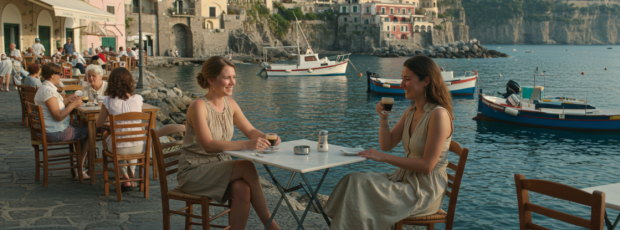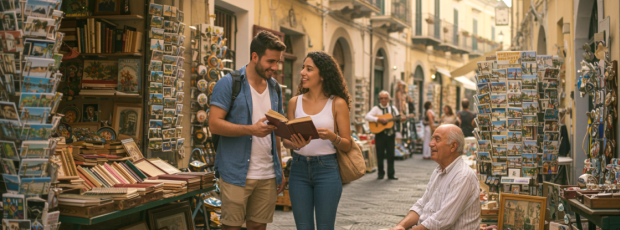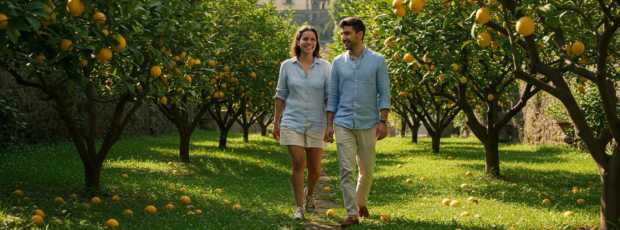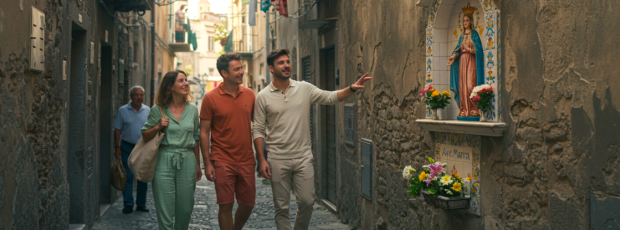Table Of Contents
- Morning Rituals at Piazza Tasso
- The Art of Strolling Corso Italia
- Marina Grande: Where Fishermen Still Fish
- Boat Tours: Skip the Crowds, Find the Coves
- Beach Clubs and Hidden Beaches
- Day Trip Strategy: Pompeii, Capri, and Mount Vesuvius
- Exploring the Sorrentine Peninsula
- Evening Sophistication
- Smart Souvenir Shopping
- Planning Your Perfect Day
- The Sorrento You'll Remember
Let me tell you something about Sorrento. Half the people who visit here never actually see the real place. They stumble off cruise ships, clutching their cameras, snapping photos of lemon trees planted for tourists, and call it authentic Italy.
Sorrento offers experiences that go far beyond ticking boxes. Whether you're planning a trip to Sorrento or already here, this guide will show you scenic spots that most tourists miss.
Morning Rituals at Piazza Tasso
Start your day where every self-respecting Sorrentino does. Piazza Tasso. Named after the Renaissance poet Torquato Tasso, who was born here, the piazza serves as the perfect introduction to Sorrento's organized chaos.
The morning light hits Piazza Tasso right around 8:30, when tour buses haven't yet arrived and locals are claiming the best café tables. Order your coffee standing at the bar like everyone else. Most locals don't drink cappuccino after 11 AM, though bar policies vary.
From Piazza Tasso, you can see straight down to the Bay of Naples, with Mount Vesuvius looming in the distance. These spectacular views explain why everyone from emperors to tourists has been drawn to visit Sorrento. If you're staying at a hotel in the historic center, this walk takes just a few minutes.
The Art of Strolling Corso Italia
Corso Italia is Sorrento's main pedestrian street, and if you're doing it right, you'll walk it at least three times during your stay. Each pass reveals something new, like hidden courtyards, local long-standing leather artisans, or glimpses of the historic center that guidebooks somehow miss. This is the perfect place to spend a few hours browsing traditional Italian crafts.
The historic center spreads out like a maze from Corso Italia, and getting lost here is required. Follow the sound of church bells to find the Basilica di Sant'Antonino, where locals pray to Sorrento's patron saint. Or let your nose guide you to bakeries tucked away in narrow alleys.
Don't be fooled by souvenir shops selling mass-produced "limoncello" and plastic lemons. The real treasures are workshops where artisans practice intarsia, creating wooden inlays that have long been a Sorrento specialty since the 18th century.
Looking for a private city experience in Sorrento?
Explore the city with a local who plans a private day just for you; no groups, no scripts.
Marina Grande: Where Fishermen Still Fish
While everyone fights for space on Piazza Tasso terraces, walk down to Marina Grande. This ancient fishing village sits at the bottom of cliffs, connected to the town above by a steep path that keeps casual tourists away. You can reach Marina Grande by bus or arrange a private transfer if you prefer easier transportation around Sorrento.
Marina Grande is where you'll find the best fresh fish in Sorrento, served at restaurants that have been feeding locals for generations. Boats head out before dawn, and if you time it right, you can watch the morning catch being brought in. Restaurant owners will tell you exactly which boat caught your lunch. Plan to spend at least a full day here if you want to relax and experience the authentic fishing village rhythm.
This is where you'll get your most authentic taste of local cuisine. Down here, spaghetti alle vongole contains clams caught this morning, and family recipes for dishes like linguine alle alici have been passed down through generations. The ferry to Capri also departs from nearby, making this a perfect place to plan your island visit.
Boat Tours: Skip the Crowds, Find the Coves
About those boat tours. Every travel blogger will tell you to take a boat tour of the Amalfi Coast, and they're right. But they're wrong about how to do it. Large tour boats departing from Sorrento port are floating parties packed with people who think the Blue Grotto is the only cave worth seeing.
Instead, book a private boat trip with local captains who know every hidden cove between Sorrento and Positano. They'll show you swimming spots that don't appear on any map, and they know which restaurants in Amalfi serve food worth the detour. Yes, it costs more than a standard tour, but you'll understand why when you're floating in crystal-clear water.
The Amalfi Coast stretches from Sorrento to Salerno, but the most spectacular section runs from Positano to Amalfi. A boat tour along this coast reveals dramatic cliffs, hidden beaches, and charming fishing villages impossible to reach by land.
The Blue Grotto on Capri is genuinely spectacular, but genuinely crowded. Book your boat tour for early morning or late afternoon, when the light is better and the queues are shorter. The island of Capri offers much more than just the Blue Grotto, but most tourists never venture beyond the main attractions. A good boat tour will show you secluded coves around Capri, perfect for swimming away from crowds.
Beach Clubs and Hidden Beaches
Sorrento isn't known for its beaches, which is probably why the ones it has are so good. Most visitors assume beach clubs are tourist traps, but the right ones are where locals spend their rare time off.
Marina Piccola offers a different perspective than its larger cousin, with quieter beach clubs that serve excellent seafood. It's also where you'll catch some of the best sunsets on the Sorrento coast, without the crowds that pack more famous viewpoints.
The secret to enjoying beaches around Sorrento is understanding they're about diving into clear water, then climbing back up to a terrace where someone's nonno grills the catch while arguing about football. The sea here is warm enough for swimming from late spring through early fall.
What if your day in Sorrento was planned by someone who knows it — and you?
City Unscripted matches you with a local host who creates a private experience based on your interests, not a set route.
Day Trip Strategy: Pompeii, Capri, and Mount Vesuvius
Everyone tells you to visit Pompeii, and they're right. But they're wrong about when to go. The ancient Roman city is one of the world's most important archaeological sites, but also one of the most crowded. Skip midday madness and arrive first thing in the morning or in the last few hours before closing.
Pompeii preserves daily life from 79 AD. Walk through the Forum, peer into ancient brothels, and stand where Romans shopped and lived. The city's preservation is so complete that you can still see ruts worn by chariot wheels in stone streets. A Rick Steves guide can help navigate the site, but nothing beats having a local show you hidden corners most tourists miss.
You can reach Pompeii by train from Sorrento in about 30 minutes, with frequent service throughout the day. Many visitors spend a full day at Pompeii, barely enough time to see the main attractions. If you're serious about understanding the site, consider a guided tour focusing on the most important areas.
Capri presents a different challenge. The island has been a playground for the wealthy since Emperor Tiberius built his villa here. Day trip crowds can be overwhelming, but if you plan strategically, you can find moments of magic. Take the early ferry from Sorrento, skip crowds at the Blue Grotto (unless you're set on it), and focus on views from Villa Jovis or the Gardens of Augustus.
The island of Capri is small enough to visit in a day, but large enough to get lost in. Most tourists stick to the main town of Capri and the resort area of Anacapri, but the island's real beauty lies in quieter corners. The ferry ride to Capri takes about 20 minutes from Sorrento.
Don't try to visit both Pompeii and Capri on the same day. Each destination deserves full attention, and rushing between them means missing subtle details that make each place special. Sorrento is the perfect base for these day trips, and many visitors find it their preferred choice for exploring the region.
Mount Vesuvius looms over the Bay of Naples like a sleeping giant. The volcano that destroyed Pompeii and Herculaneum is still active, and standing on its rim gives you perspective on the power that reshaped this region. The trail to the summit is manageable for most fitness levels, and views over Naples and the bay are worth the effort.
You can reach Mount Vesuvius by bus from Pompeii, making it possible to visit both sites in one day if you start early. The volcano offers spectacular views over the entire Bay of Naples, from Sorrento to Naples to the islands beyond.
Exploring the Sorrentine Peninsula
The Sorrentine Peninsula extends far beyond Sorrento itself, and the Punta Campanella marine reserve offers some of the most dramatic scenery in the region. This is where the peninsula ends and the open Mediterranean begins, with hiking trails leading to viewpoints most visitors never see.
Early fall is the perfect time to explore these trails, when summer crowds have retreated but the weather is still warm enough for swimming in hidden coves. The marine reserve protects some of the clearest water in the Mediterranean, with paths that offer views that stretch from Naples to Amalfi.
The peninsula also hides picturesque villages that feel like they belong in a different century. These communities have resisted tourist development that transformed other parts of the Amalfi Coast, maintaining their character as working fishing and farming towns.
Evening Sophistication
As day-trippers retreat to their hotels, Sorrento reveals its more sophisticated side. The evening passeggiata along Corso Italia takes on a different character, with locals emerging for their daily social ritual. This is when you'll see the real Sorrento. Families with strollers, teenagers showing off new outfits, and elderly couples who've been walking this same route for decades.
Wine bars that open in the evening serve wines from small producers around Naples and the Amalfi Coast. These aren't tourist-friendly establishments serving mediocre wine at inflated prices. They're serious places where locals gather to discuss everything from politics to gossip, and where wine selection reflects the owner's personal relationships with winemakers.
This is also the perfect time to walk through quieter neighborhoods around Sorrento, where residential streets reveal how locals live. It's easy to spend an entire day walking and observing, letting the rhythm of life in this ancient town wash over you.
Tip
We match you with the right host, not just any guide.Want to experience the real Sorrento with someone who lives there?
A fully private experience, planned and led by a local host who tailors the day to you
Smart Souvenir Shopping
Before you leave, you'll want to take something home that represents Sorrento. Skip the mass-produced "limoncello" sold in lemon-shaped bottles and the plastic souvenirs that could have been made anywhere. Instead, look for the workshops where artisans still practice traditional crafts.
The intarsia workshops create wooden objects using techniques passed down through generations. A small jewelry box or picture frame made here will last forever and actually tell the story of Sorrento's craftsmanship tradition. Similarly, local limoncello producers use lemons grown in nearby groves, and their products taste completely different from commercial versions.
For food souvenirs, visit the small shops that sell locally made pasta, olive oil from groves on the peninsula, and preserves made from local citrus. These products carry the authentic flavors of the region, and supporting these small producers helps maintain the traditional economy that makes Sorrento special. Many shops also sell leather goods made by local craftspeople, offering quality that you won't find in the tourist areas.
Planning Your Perfect Day
The key to experiencing Sorrento like a local is understanding that it's not about rushing from sight to sight. It's about finding the rhythm of daily life and letting yourself be part of it for a few hours. Start early when light is best and crowds are thinnest. Take a long lunch at Marina Grande. Spend the afternoon on a boat tour or exploring the peninsula. End with an evening stroll and a proper dinner.
Whether you're here for a day trip from Naples or as a base for exploring the Amalfi Coast, Sorrento rewards visitors who take the time to look beyond the obvious. The town's charm lies in its ability to maintain its authentic character while welcoming visitors from around the world.
Transportation around Sorrento is easy, with regular bus service connecting main attractions and ferry connections to Capri, Positano, and Amalfi. The train from Naples brings you directly to the center of town, making Sorrento accessible whether you're staying in the city or using it as a base for exploring the coast. Be sure to check current timetables for boats, buses, and trains, as schedules can vary seasonally.
If you're traveling with children, consider exploring some of the things to do in Sorrento with kids that focus on activities that locals enjoy. For a more comprehensive look at authentic local activities, check out our guide to Sorrento experiences that go beyond the typical tourist offerings.
The Sorrento You'll Remember
What you'll remember about Sorrento isn't the crowds or the clichés. It's the moment when you're sitting on a terrace in Marina Grande, watching fishing boats return while the sun sets over the Bay of Naples. It's the taste of actual limoncello made from lemons grown in volcanic soil. It's the realization that the best views aren't always the most famous ones.
Sorrento has been charming visitors for over two thousand years, and it has perfected the art of being both accessible and authentic. The secret is knowing where to look, when to arrive, and how to move through the town like someone who belongs here. Whether you spend a few hours or an entire day exploring, Sorrento offers layers of experience that reveal themselves slowly.
The perfect place to end your visit is back where you started, Piazza Tasso at sunset, when day-trippers have departed and locals reclaim their town. From here, you can see lights beginning to twinkle in villages across the bay, and you'll understand why so many people fall in love with this corner of Italy. Now you know. Use this knowledge wisely.
Ready to plan your perfect day in Sorrento?
Start your experienceWhat if your day in Sorrento was planned by someone who knows it — and you?
City Unscripted matches you with a local host who creates a private experience based on your interests, not a set route.
Want to experience the real Sorrento with someone who lives there?
A fully private experience, planned and led by a local host who tailors the day to you











